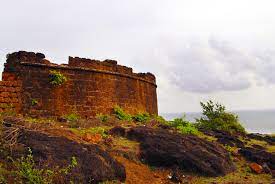Bollywood felt a need for locations where moments in cinema could be added. Unquestionably, architecture brings out the artistic side to cinema vis-à-vis as cinema compliments the modern and the timeless architecture that we see today.
Indian-way of life and culture Is diverse in art and architecture. Home of forts and monuments especially North India showcases ancient Indian, Mughal and European architectural marvels. Travelling deep down south India, we witness the Dravidian temples with lavish embellishment. East reflects the heritage houses exude a strong British influence.
A quick-peek into some finest examples of Indian architecture through Bollywood-cinematography is showcased below-
Chittorgarh Fort, Chittorgarh, Rajasthan. (Padmaavat)

UNESCO World Heritage, in Chittorgarh, Rajasthan, covers 700 acres, as the largest-fort in Asia. Chittorgarh Fort, perfect filming location for a fort complex full of palaces, temples, towers, and a reservoir.
Steeped-fort structured by the magnificent courtyard and the unique mahals, boasts of extraordinary features in historic and architectural backdrops of fervent and fiery sceneries. Integrated from Hindu architecture, The Fort has constructions decorated with inlay work in granite stones with illustration of living beings in decorative art. Originally featured 84 water bodies, today only 22 remain. A film-maker’s dream-location. The backdrop for the iconic scene from Bollywood movie ‘Yeh Jawani Hai Deewani’ where Bunny (Ranbir Kapoor) enjoys the sunset with Naina (Deepika Padukone). Scenes from Bhansali’s ‘Padmaavat’ too are shot in Chittorgarh Fort, as this is the original site where Rani Padmini of Chittor performed jauhar. ‘Padmaavat’ is Director, Sanjay Leela Bhansali’s masterpiece; wouldn’t have seemed more realistic hadn’t the scenes been shot here.
Agrasen Ki Baoli, Delhi (PK & Dabangg)

A Persian-architectural marvel and a beautiful historic site 60-meter long, 15-metre wide structure consisting of 103 steps made of red stone step-well located on Hailey Road, New Delhi, Agrasen Ki Baoli is an ancient water reservoir which is a protected monument now under the Ancient Monuments and Archaeological Sites and Remains Act, 1958 of the Archaeological Survey of India.
A location of witness globally and a splendid tourist-attraction, Agrasen Ki Baoli also happens to be a popular Bollywood filming site. The site has been featured in Salman Khan Bollywood starrer ‘Dabangg’ and Amir Khan starrer ‘PK’, among many other films with the purpose of exhibiting an Indian-cultural feel. A movie-maker’s delight as the site caters to the essence of Indianism and India’s rich culture and heritage. A word of caution though! Agrasen Ki Baoli, is reported to be a haunted place of visit.
Nahargarh Fort, Rajasthan (Rang De Basanti)
Perched atop the Aravalli Hills of Rajasthan, overlooking the pink city Jaipur, Maharaja Sawai Jai Singh II in 1734 AD built the mesmerising fort of Nahargarh with the purpose of defence. Popular for historic reminiscence and rich architecture, the fort is a paradise for filming. The famous song ‘Masti Ki Paathshala’ from ‘Rang De Basanti’ was shot here. The unforgettable cinematic-experience was created portraying a group of young, vibrant college students, Diljeet (Aamir Khan) and Sukhi (Sharman Joshi) who were shown free-falling after drinking from the heights of the public water tank of the fort . .
Doraha Fort, Punjab (Rang De Basanti)
Doraha Sarai or Mughal Sarai of Doraha, Ludhiana District was built by the Mughal ruler Jehangir to shelter Mughal caravans. The Doraha Fort came into vogue and gained immense popularity after it was featured in the movie – ‘Rang De Basanti’. The emblematic scenes of the immensely popular song ‘Tu Bin Bataye’ when R Madhavan proposes to Soha Ali Khan was shot here. The symbolic-Mughal Fort covers 8.67 acres (3.507 hectares) of total.area. The epitome of Mughal-architecture is also known as the RDB Fort.
Fort Chapora, Goa (Dil Chahta Hai)

High above the Chapora-river of Bardez, Goa ruler Adil Shah built a Fort called Shahpura, later renamed as Chapora by the Portuguese. The Fort which was built over 404 years ago bloomed with further prominence as special-scenes from the movie on everlasting-friendship ‘Dil Chahta Hai’ was shot here. Turned into as an embodiment or symbol of delightful-promising friendship, visitors mostly youth capture snaps sitting at the walls of the Fort. Ever-since, the ancient-marvel is popularly renamed by many film-lovers as the ‘Dil Chahta Hai’ Fort.
Image Credit: To Respective Owners





















